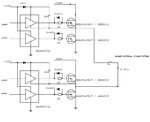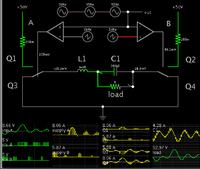franticEB
Full Member level 3
Hi,
i'm designing and realizing on prototype board a full bridge class D amplifier.
The switching losses of mosfets are higher than those provided by the calculations.
The DC voltage is 250V and Fswitching=50KHz Pout=150Wrms.
My question is: is there in literature a ZVS class d amplifier example? Is it possible to realize it?
If yes is there any tutorial or application from which start the design?
If not could you suggest me a suitable kind of mosfet to be used, tutorial or handbook on that kind of amplifer?
Thanks a lot...
i'm designing and realizing on prototype board a full bridge class D amplifier.
The switching losses of mosfets are higher than those provided by the calculations.
The DC voltage is 250V and Fswitching=50KHz Pout=150Wrms.
My question is: is there in literature a ZVS class d amplifier example? Is it possible to realize it?
If yes is there any tutorial or application from which start the design?
If not could you suggest me a suitable kind of mosfet to be used, tutorial or handbook on that kind of amplifer?
Thanks a lot...

